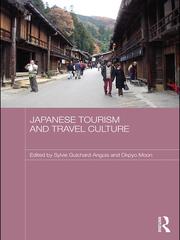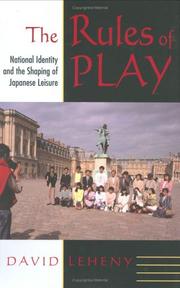| Listing 1 - 7 of 7 |
Sort by
|

ISBN: 9780415674461 9780415470018 0415470013 9780203886670 0203886674 9781134104789 9781134104826 Year: 2011 Publisher: London ; New York : Routledge,
Abstract | Keywords | Export | Availability | Bookmark
 Loading...
Loading...Choose an application
- Reference Manager
- EndNote
- RefWorks (Direct export to RefWorks)
Travelers --- Tourism --- National characteristics, Japanese. --- Voyageurs --- Tourisme --- Japonais --- National characteristics, Japanese --- J4160 --- J4535 --- Japanese national characteristics --- Japan: Sociology and anthropology -- customs, folklore and culture -- festivals, holidays and tourism --- Japan: Economy and industry -- commerce and trade -- tourism, travel industries

ISBN: 1501731890 9781501731891 0801440912 9780801440915 Year: 2018 Publisher: Ithaca, NY : Cornell University Press,
Abstract | Keywords | Export | Availability | Bookmark
 Loading...
Loading...Choose an application
- Reference Manager
- EndNote
- RefWorks (Direct export to RefWorks)
The Japanese government seeks to influence the use of leisure time to a degree that Americans or Europeans would likely find puzzling. Through tourism-promotion initiatives, financing for resort development, and systematic research on recreational practices, the government takes a relentless interest in its citizens' "free time." David Leheny argues that material interests are not a sufficient explanation for such a large and consistent commitment of resources. In The Rules of Play, he reveals the link between Japan's leisure politics and its long-term struggle over national identity.Since the Meiji Restoration, successive Japanese governments have stressed the nation's need to act like a "real" (that is, a Western) advanced industrial power. As part of their express desire to catch up, generations of policymakers have examined the ways Americans and Europeans relax or have fun, then tried to persuade Japanese citizens to behave in similar fashion-while subtly redefining these recreational choices as distinctively "Japanese."In tracing the development of leisure politics and the role of the state in cultural change, the author focuses on the importance of international norms and perceptions of Japanese national identity. Leheny regards globalization as a "failure of imagination" on the part of policymakers. When they absorb lessons from Western nations, they aim for a future that has already been revealed elsewhere rather than envision a locally distinctive lifestyle for citizens.
Leisure --- Free time (Leisure) --- Leisure time --- Recreation --- Economic aspects --- Government policy --- J4160 --- J4101 --- Japan: Sociology and anthropology -- customs, folklore and culture -- festivals, holidays and tourism --- Japan: Sociology, anthropology and culture -- policy, legislation, guidelines, codes of behavior
Book
ISBN: 2716901627 Year: 1982 Publisher: Paris : Publications orientalistes de France,
Abstract | Keywords | Export | Availability | Bookmark
 Loading...
Loading...Choose an application
- Reference Manager
- EndNote
- RefWorks (Direct export to RefWorks)
No --- Fasts and feasts --- Fêtes religieuses --- Kasuga Jihsha, Kushibiki-cho, Japan --- J4160 --- J6834 --- Japan: Sociology and anthropology -- customs, folklore and culture -- festivals, holidays and tourism --- Japan: Performing arts and entertainment -- nō and kyōgen (noh) --- Nō --- Fêtes religieuses --- Kasuga Jihsha, Kushibiki-chō, Japan
Book
ISBN: 2716901589 9782716901581 Year: 1982 Publisher: Paris: Publications orientalistes de France,
Abstract | Keywords | Export | Availability | Bookmark
 Loading...
Loading...Choose an application
- Reference Manager
- EndNote
- RefWorks (Direct export to RefWorks)
J4160 --- J6826 --- J1714 --- No --- -Noh --- Shimai --- Theater --- Japan: Sociology and anthropology -- customs, folklore and culture -- festivals, holidays and tourism --- Japan: Performing arts and entertainment -- theater --- Japan: Religion in general -- sociology of religion --- -Japan: Sociology and anthropology -- customs, folklore and culture -- festivals, holidays and tourism --- Festivals --- New Year --- Nō --- Noh --- New Year's Day --- New Year's Eve --- Holidays --- Religious aspects --- Moral and religious aspects

ISBN: 0791437914 0791437922 Year: 1998 Publisher: Albany (N.Y.) SUNY Press
Abstract | Keywords | Export | Availability | Bookmark
 Loading...
Loading...Choose an application
- Reference Manager
- EndNote
- RefWorks (Direct export to RefWorks)
J4142 --- J4150 --- J4160 --- J6900 --- J6800 --- J6850 --- Leisure --- -Recreation --- -Manners and customs --- Amusements --- Community centers --- Free time (Leisure) --- Leisure time --- Recreation --- Japan: Sociology and anthropology -- cultural trends and movements in general --- Japan: Sociology and anthropology -- customs, folklore and culture --- Japan: Sociology and anthropology -- customs, folklore and culture -- festivals, holidays and tourism --- Japan: Sports and recreation -- general and history --- Japan: Performing and media arts -- general and history --- Japan: Games, toys and hobbies in general --- Social aspects --- -Social aspects --- -J4142 --- -Free time (Leisure) --- -Leisure --- Manners and customs
Book
ISBN: 9784866580647 486658064X Year: 2019 Publisher: Tokyo: Japan Publishing Industry Foundation for Culture,
Abstract | Keywords | Export | Availability | Bookmark
 Loading...
Loading...Choose an application
- Reference Manager
- EndNote
- RefWorks (Direct export to RefWorks)
Religion and tourism seem to be an unlikely pair, but in fact, taking a look at these two human behaviors provides an invaluable insight into modern society. In the past, holy sites were of immense importance to those who followed a particular religion, and these places used to attract many faithful pilgrims. These days, however, people without faith visit holy places simplu to experience something out of the ordinary. Furthermore, many places without any connection to religion are being called "sacred" and are attracting people's interest. What really drives people there, and what do people want to gain from the experience ? In this informative book, the author discusses various pilgrimages in order to shed light on new types of religious views and faiths that have come into being in the twenty-first century. The book explores the Santiago pilgrimage in Spain ; the eighty-eight temple pilgrimage in Shikoku, Japan ; B-grade tourist spots ; so-called "power spots", sacred anime sites ; and much more. This is a must-read for researchers investigating the link between tourism and religion and how the two influence each other.
Tourism --- Pilgrims and pilgrimages --- Popular culture --- J4160 --- J1810 --- J1918 --- J1928 --- J1990 --- Culture, Popular --- Mass culture --- Pop culture --- Popular arts --- Communication --- Intellectual life --- Mass society --- Recreation --- Culture --- Pilgrimages and pilgrims --- Processions, Religious --- Travelers --- Voyages and travels --- Shrines --- Holiday industry --- Operators, Tour (Industry) --- Tour operators (Industry) --- Tourism industry --- Tourism operators (Industry) --- Tourist industry --- Tourist trade --- Tourist traffic --- Travel industry --- Visitor industry --- Service industries --- National tourism organizations --- Travel --- Religious aspects --- Social aspects --- Japan: Sociology and anthropology -- customs, folklore and culture -- festivals, holidays and tourism --- Japan: Religion -- Buddhism -- temples and monastries, pilgrimage --- Japan: Religion -- Shintō -- shrines and pilgrimage --- Japan: Religion -- Christianity -- churches, monasteries, pilgrimage --- World: Religion --- Economic aspects --- Pilgrims and pilgrimages. --- Religious aspects. --- Social aspects. --- Japan. --- Japan: Religion -- Buddhism -- temples and monasteries, pilgrimage --- Spiritual tourism --- Tourism - Japan - Religious aspects --- Tourism - Religious aspects --- Popular culture - Social aspects
Book
ISBN: 0520967232 0520293916 9780520967236 9780520293915 Year: 2017 Publisher: Oakland, California : University of California Press,
Abstract | Keywords | Export | Availability | Bookmark
 Loading...
Loading...Choose an application
- Reference Manager
- EndNote
- RefWorks (Direct export to RefWorks)
"Placing Empire examines the spatial politics of Japanese imperialism through a study of Japanese travel and tourism to Korea, Manchuria, and Taiwan between the late nineteenth century and the early 1950s. In a departure from standard histories of Japan, this book shows how debates over the place of colonized lands reshaped the social and spatial imaginary of the modern Japanese nation and how, in turn, this sociospatial imaginary affected the ways in which colonial difference was conceptualized and enacted. In so doing, it illuminates how ideas of place became central to the production of new forms of colonial hierarchy as empires around the globe transitioned from an era of territorial acquisition to one of territorial maintenance"--Provided by publisher.
J3374 --- J3491.10 --- J4160 --- Tourism --- Holiday industry --- Operators, Tour (Industry) --- Tour operators (Industry) --- Tourism industry --- Tourism operators (Industry) --- Tourist industry --- Tourist trade --- Tourist traffic --- Travel industry --- Visitor industry --- Service industries --- National tourism organizations --- Travel --- Japan: History -- Kindai, modern -- Meiji period (1868-1912) -- imperial expansion --- Japan: Geography and local history -- others -- Asia -- East Asia (colonial) --- Japan: Sociology and anthropology -- customs, folklore and culture -- festivals, holidays and tourism --- Political aspects --- Economic aspects --- Japan --- Korea --- Manchuria (China) --- Taiwan --- Nihon --- Nippon --- Iapōnia --- Zhāpān --- I︠A︡ponii︠a︡ --- Yapan --- Japon --- Japão --- Japam --- Mư̄ang Yīpun --- Prathēt Yīpun --- Yīpun --- Jih-pen --- Riben --- Government of Japan --- 日本 --- 日本国 --- Nipponkoku --- Nippon-koku --- Nihonkoku --- Nihon-koku --- State of Japan --- Япония --- Japani --- اليابان --- al-Yābān --- يابان --- Yābān --- Japonsko --- Giappone --- Japonia --- Japonya --- Colonies --- Description and travel. --- Description and travel --- E-books --- Taiwan Sheng zheng fu --- Tʻai-wan sheng cheng fu --- Taiwan xing zheng zhang guan gong shu --- Tʻai-wan hsing cheng chang kuan kung shu --- Taiwan Sheng xing zheng zhang guan gong shu --- Tʻai-wan sheng hsing cheng chang kuan kung shu --- Tʻai-wan --- Taĭvan --- Formosa --- Taiwan Sōtokufu --- Government-General of Taiwan --- Taiwan sheng --- Tʻai-wan sheng --- Taiwan Provincial Government --- Taiwan zong du fu --- Tʻai-wan tsung tu fu --- Xiaoliuqiu --- 臺灣 --- 台灣 --- Тайвань --- Tajvan --- Тайуан --- Taĭuan --- Tayiwani --- Taywan --- Taivanas --- Taiwana --- Taihuan --- Тайван --- China (Republic : 1949- ) --- China, Northeast --- Northeast China --- 1950s. --- 19th century. --- 20th century. --- boundaries. --- colonial. --- colonialism. --- colonized lands. --- colonized. --- contemporary. --- empire. --- global. --- japanese history. --- japanese imperialism. --- japanese tourism. --- japanese travel. --- japanese. --- korea. --- manchuria. --- modern world. --- post colonial. --- social studies. --- speaking japanese. --- taiwan. --- territorial maintenance. --- territorial. --- territory. --- tourism. --- tourist. --- History --- Jepun --- Yapon --- Yapon Ulus --- I︠A︡pon --- Япон --- I︠A︡pon Uls --- Япон Улс
| Listing 1 - 7 of 7 |
Sort by
|

 Search
Search Feedback
Feedback About UniCat
About UniCat  Help
Help News
News